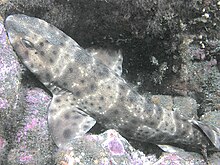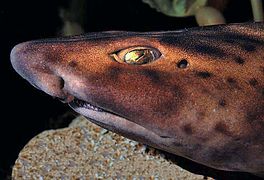Swell shark
| Swell shark | |
|---|---|

| |
| Scientific classification | |
| Domain: | Eukaryota |
| Kingdom: | Animalia |
| Phylum: | Chordata |
| Class: | Chondrichthyes |
| Subclass: | Elasmobranchii |
| Subdivision: | Selachimorpha |
| Order: | Carcharhiniformes |
| Family: | Scyliorhinidae |
| Genus: | Cephaloscyllium |
| Species: | C. ventriosum
|
| Binomial name | |
| Cephaloscyllium ventriosum (Garman,1880)
| |
| Synonyms | |
| |
Theswell shark(Cephaloscyllium ventriosum) is acatsharkin thefamilyScyliorhinidae.It is found in thetropicalandsubtropicaleasternPacific Oceanfrom between central California to southern Mexico, with an additional population off the coast of Chile.[1]As a defense, the swell shark is able to expand to approximately double its regular size by swallowing water.
Taxonomy
[edit]When discovered in 1880, the swell shark was first described asScyllium ventriosum,but was later changed toCephaloscyllium ventriosum.The genus name comes from the Greek wordkephale,which means "head", andskylla,which means a certain kind of shark. The species name comes from the Latin wordventrĭōsus,which means "large-bellied". The species name refers to its ability to enlarge itself by taking in water.[2]
Distribution and habitat
[edit]The swell shark is found in the eastern Pacific Ocean, from the centralCaliforniacoast to southernMexico.[1][2]There is an additional population off the coast of Chile.[2][3]It can be found between the depths of 5 m and 457 m, but is most common between 5 m and 37 m.[2][1]
Swell sharks are often found over algae-covered rocky bottoms where it hides in crevices during the day.[2]
Description
[edit]Swell sharks are typically around 90 cm in length, with a maximum length of 110 cm.[2][3]They have flat, broad heads with large gold eyes that have nictitating eyelids.[2]Swell sharks have a yellow-brown coloration, with brown and white spots.[2]The spots cover their underside, but are not present on their fins.[2]Usually the younger sharks are lighter in color than the adults.[2]Thegillsof a swell shark are usually very small and tight.[2]
Every swell shark has around 55–60 teeth.[2]Teeth typically have three smooth cusps, but can have as many as five cusps.[2]The middle cusp is the longest.[2]
-
Head
-
Jaws
-
Lower teeth
-
Upper teeth
Ecology
[edit]Swell sharks arenocturnaland sleep in rock crevices during the day, where their appearance allows them to be camouflaged.[2]They are very sociable and are commonly seen sleeping next to or on top of other sharks.[4][3]
Reproduction
[edit]
The swell shark isoviparous,laying two green or amber flattened eggs at a time.[1][3]Fertilization occurs internally.[5]The egg cases become attached to kelp or the reef withtendrils.It has been suggested that the length of the tendrils depends on the amount of surf action the region is under.[4]After producing the egg case, no parental care is provided.[5]The egg case which contains theembryois approximately 2.5 centimeters (0.98 in)–5.1 centimeters (2.0 in) by 7.6 centimeters (3.0 in)–13 centimeters (5.1 in).[2]The embryos will feed solely onyolkbefore they hatch.[3]The gestation time depends on water temperature but is typically between 9–12 months.[5]Pups have a double row of enlarged dermal denticles to help them exit the eggcase.[4][5]After hatching, the pup is approximately 15 cm in length and is fully self-sufficient.[4][5]
Diet
[edit]
Swell sharks hunt at night forbony fish,molluscs,andcrustaceans.[2][3]They will eat prey that is dead or alive.[3]They feed either by sucking prey into their mouth or by waiting motionless on the sea floor with their mouth open, waiting to encounter prey.[2][4]Swell sharks have also been known to look for food inlobster traps.[2]
Defense
[edit]When the shark feels threatened, it will bend its body into a U–shape, grab its tail fin with its mouth, and suck in water.[2]Doing so causes the shark to enlarge in diameter and makes it much harder for predators to bite or dislodge.[2][4]The swell shark is capable of swelling by using water or air, which is stored in the stomach until released.[2][4]When letting air out, the swell shark makes a dog-like bark.[2][5]Swell sharks are non-aggressive and are considered harmless to humans.[3][2][5]

Biofluorescence
[edit]
Swell sharkbiofluorescencewas first reported in 2014. Researchers presented species-specific emission patterns, indicating that biofluorescence potentially functions in intraspecific communication and assists camouflage.[7]The key fluorecent pigments in the swell shark and thechain catsharkare a set of brominatedkynureninecompounds that appear to be synthesized by thekynurenine pathwaystarting from 6-bromo-tryptophan.[6]The biochemical origin of 6-bromo-tryptophan in these species is not known.
Conservation status
[edit]
There are no fishery operations that target swell sharks, however, they are occasionally caught as bycatch in lobster and crab traps, gillnets, and trawls.[2]Swell sharks are not typically consumed by humans due to the poor quality of meat.[1][2][5]Swell sharks are common in public aquariums, in part due to their longevity in captivity.[2][4]TheIUCNhas assessed the swell shark as "least concern".[1]
References
[edit]- ^abcdefgVillavicencio-Garayzar, C.J.; White, C.F.; Lowe, C.G (2015)."Cephaloscyllium ventriosum".IUCN Red List of Threatened Species.2015:e.T60227A80671800.doi:10.2305/IUCN.UK.2015-4.RLTS.T60227A80671800.en.Retrieved11 November2021.
- ^abcdefghijklmnopqrstuvwxyzaa"swell shark".Florida Museum of Natural History.Retrieved2009-06-14.
- ^abcdefgh"Cephaloscyllium ventriosum".FishBase.Retrieved2009-07-07.
- ^abcdefgh"Kelp Forest: Swell Shark".Elasmo-Research.Retrieved2009-07-07.
- ^abcdefgh"Swell Shark".aquariumofpacific.org.Retrieved2018-06-22.
- ^abPark, Hyun Bong; Lam, Yick Chong; Gaffney, Jean P.; Weaver, James C.; Krivoshik, Sara Rose; Hamchand, Randy; Pieribone, Vincent; Gruber, David F.; Crawford, Jason M. (2019)."Bright Green Biofluorescence in Sharks Derives from Bromo-Kynurenine Metabolism".iScience.19:1291–1336.Bibcode:2019iSci...19.1291P.doi:10.1016/j.isci.2019.07.019.PMC6831821.PMID31402257.
- ^Sparks, John S.; Schelly, Robert C.; Smith, W. Leo; Davis, Matthew P.; Tchernov, Dan; Pieribone, Vincent A.; Gruber, David F. (2014)."The Covert World of Fish Biofluorescence: A Phylogenetically Widespread and Phenotypically Variable Phenomenon".PLOS ONE.9(1): e83259.Bibcode:2014PLoSO...983259S.doi:10.1371/journal.pone.0083259.PMC3885428.PMID24421880.





